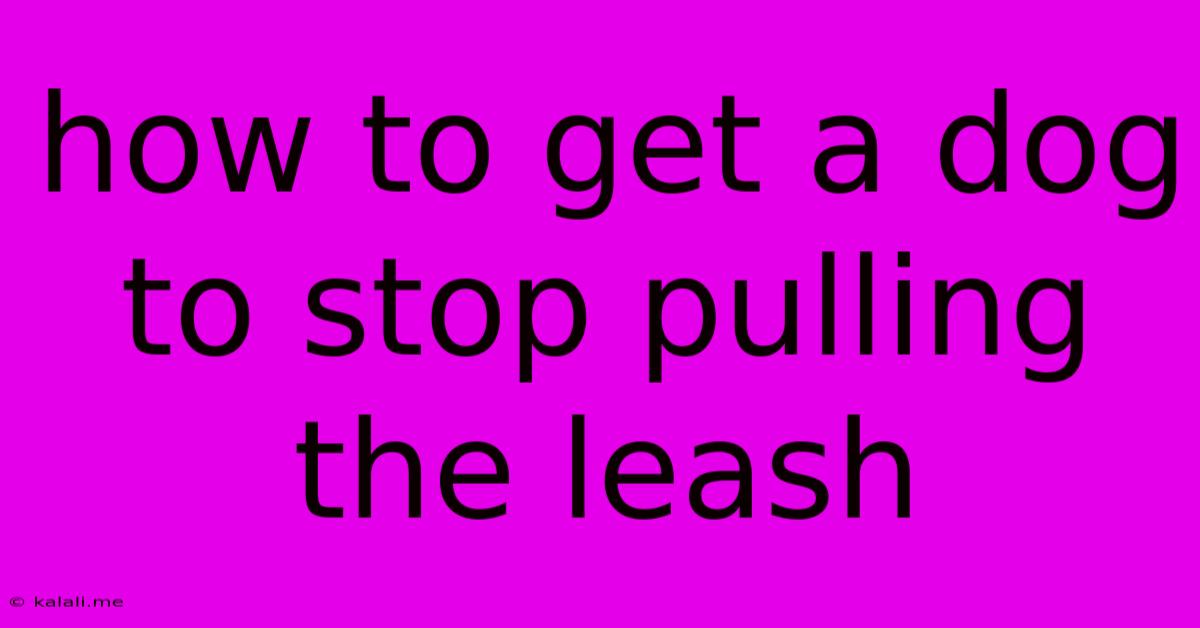How To Get A Dog To Stop Pulling The Leash
Kalali
Jun 08, 2025 · 3 min read

Table of Contents
How to Stop Your Dog From Pulling on the Leash: A Comprehensive Guide
Is your dog a human-powered locomotive? Does walking your furry friend feel more like a tug-of-war than a leisurely stroll? Pulling on the leash is a common problem, but with patience and the right techniques, you can teach your dog to walk politely by your side. This comprehensive guide will equip you with the knowledge and strategies to transform your walks from a battle into a bonding experience.
Understanding Why Dogs Pull
Before diving into solutions, it's crucial to understand why your dog pulls. Dogs pull for various reasons, including excitement, scent-tracking, fear, or simply because they haven't learned better leash manners. Identifying the underlying cause can help tailor your training approach.
Effective Methods to Curb Leash Pulling
Here are some proven methods to address leash pulling, ranging from simple adjustments to more advanced training techniques:
1. Equipment Matters: Choosing the Right Leash and Harness
- Harnesses: Front-clip harnesses gently redirect your dog's body when they pull, discouraging the behavior. Head halters (like Gentle Leaders) are another option, but require careful introduction and training to avoid discomfort for your dog. Avoid harnesses that only clip on the back, as these can actually encourage pulling.
- Leashes: A standard 6-foot leash is generally recommended for training. Avoid retractable leashes, as they give your dog too much freedom and can make controlling pulling difficult.
2. The Stop-and-Go Method
This classic technique works by rewarding your dog for loose-leash walking. The moment your dog pulls, immediately stop walking. Remain still until the leash slackens. Once the leash is loose, praise your dog enthusiastically and continue walking. Repeat this process consistently.
3. Reward-Based Training: Positive Reinforcement is Key
Positive reinforcement is the cornerstone of successful dog training. When your dog walks loosely by your side, reward them immediately with praise, treats, or a favorite toy. This creates a positive association between loose-leash walking and rewards.
4. Change of Pace and Direction
Unexpected changes in direction can disrupt a pulling dog's momentum. When they pull, abruptly change direction, rewarding them when they adjust their pace to stay with you. This keeps them engaged and prevents them from getting into a pulling rhythm.
5. Practice Makes Perfect: Consistency is Crucial
Consistency is paramount in leash training. Every walk is a training opportunity. Even short, frequent training sessions are more effective than infrequent, long walks. Involve family members in the training to maintain consistency.
6. Addressing Underlying Issues
If pulling is rooted in fear or anxiety, consider consulting a professional dog trainer or behaviorist. They can help identify the underlying cause and develop a customized training plan. This may involve desensitization and counter-conditioning techniques.
Beyond the Basics: Advanced Techniques
For dogs who are persistent pullers, these advanced techniques can be helpful:
- Loose Leash Walking Training Classes: Group classes provide professional guidance and the opportunity to practice with other dogs.
- Professional Dog Trainer Consultation: A qualified trainer can address specific challenges and create a personalized plan.
Conclusion: A Harmonious Walk Awaits
Successfully training your dog to walk politely on a leash requires patience, consistency, and positive reinforcement. By understanding the reasons behind the pulling and implementing the right techniques, you can transform your walks from stressful tugs-of-war into enjoyable bonding experiences. Remember to celebrate small victories and remain positive throughout the process – you and your furry friend will both reap the rewards!
Latest Posts
Latest Posts
-
Inconsistency Is The Hobgoblin Of Little Minds
Jun 08, 2025
-
Mac App Photo Viewer Gallery 3d Obj Support
Jun 08, 2025
-
Decks With Benches Instead Of Railings
Jun 08, 2025
-
Do Boy Cats Go In Heat
Jun 08, 2025
-
Can You Drive On A Donut
Jun 08, 2025
Related Post
Thank you for visiting our website which covers about How To Get A Dog To Stop Pulling The Leash . We hope the information provided has been useful to you. Feel free to contact us if you have any questions or need further assistance. See you next time and don't miss to bookmark.